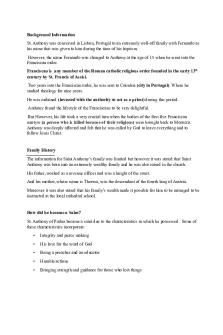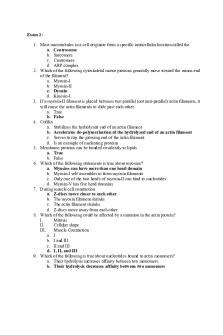Vision - Professor Anthony Uzwiak PDF

| Title | Vision - Professor Anthony Uzwiak |
|---|---|
| Course | Anatomy & Physiology II |
| Institution | The College of New Jersey |
| Pages | 4 |
| File Size | 58.9 KB |
| File Type | |
| Total Downloads | 94 |
| Total Views | 169 |
Summary
Professor Anthony Uzwiak...
Description
Vision In order to be able to detect biological stimulus such as body heat/ echolocation, need receptor that can see the range of electromagnetic spectrum Instead, we see electromagnetic radiation in what is called the visual spectrum; range of wavelengths activate receptors that we characterize as vision
We primarily see light reflected off other objects; have to use various optical components to take the light reflected off other objects and focus light onto the anatomic structure where photo receptors are localized ( which is our retina) o Position of retina to where light is entering the eye is a certain distance; ability of our eye to focus the light (cornea) and position of where photoreceptors are relative to cornea should match length of eyeball Refraction: process of bending light in such a way so that it is in focus where our photoreceptors are
Attribute of visual system that makes it important: contributed almost immediately to emergent state of brain Optics: field of physics that looks at the way light behaves
When we see something, it is reflected light off of a distant object; color we see is light that is not absorbed Three populations of cones (red, blue, green); if someone is missing those cones, any combination that requires those colors can’t be seen/ colorblind Refraction of reflected light by the lenses of the eye; lens: an optical element that can refract light
When characteristics of that optical element can refract the light in a way that the light rays come to converge to be back in focus, then that distance from the leading edge of the lens to where the light rays are in focus is called the focal line Cornea (a type of lens) extends out anteriorly; when light rays passes through from one environment to an environment with different density, it will refract; as light passes through different mediums like bends, when the medium it passes through is also curved, then the light bends at an angel that matches the angle where is encounters the surface of the lens
Light rays come through cornea and refract in cornea, then they bend in such a way that at some point they cross each other and come in focus at a distance equal to the length of the eyeball (ideally) If object is more than 9m away from cornea, the light rays are going to behave as if they’re running in straight and in parallel lines o Objects are perceived as smaller o Focal length of cornea matches length of eyeball If object is less than/closer than 9m away from cornea: some rays still running in parallel but some diverse away; as consequence, cornea cannot bend light enough and bring it into focus, so internal lens refract diverging light again to bring it in focus
o
Accommodation: adding additional conditions to offset deficiency in cornea; addition of refractive power to allow us to see things that are closer
Retina (back of the eye) object has to be in focus where the retina actually is; actual image of object is perceived as inverted and reversed Iris is muscular ring inside the eye and control how much light goes into the eye
When iris constricts, it covers over the region of the lens where diverging light rays must pass through, allowing us to see ahead and in focus; When it constricts, pupil gets smaller and only light rays going directly into the opening is shown
If looking at eye straight on: region above iris is curved; cornea (actually curved) sits right over where iris is; white part of eye is sclera which have extraocular muscles attached
Parasympathetic ring of iris: circular muscle (as you close parasympathetic iris: opening gets smaller; to make opening bigger, have to relax ring); primary function to regulate how much light goes into eye; origin at edge of sclera and insertion at inner ring of opening; opening controlled by amount of light; all muscles of iris rings attached to inside edge of iris, origin all the way around periphery
If we look at eye cross sectionally/ sagittal (cutting through iris and pupil): fluid filled space in front of lens called anterior chamber and flied is called aqueous humor ; lens attached to muscle called ciliary body with attachment point called zonular fibers; behind lens is another fluid filled area (posterior chamber) filled with thick fluid called vitreous humor;
If you take piece of wall of eyeball: sclera >retina (innermost area where photoreceptors are) > choroid (vascular layer where blood vessels are) o Retina gets thicker as you go to back of the eye (most light is focused there) o Eventually iris fold inwardly where axons are leaving to form optic nerve; region where fibers are leaving called optic disk (blind spot; no photoreceptors)
Can change curve of lens; the flatter it is the less bent the light is, the more it’s curved the more the light is going to be bent
In order to see things as they get closer, lens need to be curved more o Circular muscle all the way around inside of eye called ciliary body; lens in middle; attached to lens by zonular fibers
Retina is like a duplex; you can have two visual systems in same spot functioning in different ways (photopic and scotopic)
Photopic: on all the time but only functions when there’s enough light Scotopic: functions only on when there is no light, off when there is light; any small amount of light is processed and used; backup system
Photoreceptors that process under scotopic system are the rods and they used auto pigment called rhodopsin (purple-ish color)
Rhodopsin absorbs the light; absorbs light more efficiently than the cones
Circuitry is convergent (in retina where scotopic system is) (more like divergent; signal diverging away from the rods) The cones have opsins that absorbs red, blue, and green
Rods 1000x stronger than response of cone
Rods and cones distributed in retina in different places Where all the light is focused is the macula; fovea has most photoreceptors and surrounding retina is called peripheral retina
Rods densest around where macula is Cones primarily localized to the macula; densest in the fovea
How do photoreceptors create signal that can be used by nervous system (since they’re only responding to ? of the light)
Have to transduce light energy into nervous system based signal o Rods respond to the absence of light; in the rods there’s a signaling molecule called cGMP; no light: increases cGMP, the rising of that opens sodium channel which allows sodium to influx into the rods and then depolarizes the rod, which then causes a voltage gated calcium channel to open, which causes calcium influx, which then acts as signal to cause release of neural transmitter; signal from rod night seeing light tells NS there’s no light, until light is shone on the rods: cGMP levels decrease, sodium channels close, no influx of sodium, no depolarization of the rod, no calcium channel open, no calcium influx, no signal so no neural transmitter release
Visual field (what you can see; orbit limits how far we can see behind us, nose also blocks view ) in visual world that is divided into right and left side called right hemifield and left hemifield (not based on what you can see in left or right eye; rather divided field right in the middle; each eye can see its own hemifield plus part of other hemifield), region you can see with both eyes is binocular zone that allows for dept; visual world need to be connected to retinas then to the brain
Point of light (both sides) lateral side: temporal hemifield, point of light (both sides) close to nose: nasal hemifield o Temporal part of left hemifield: focused on ipsilateral part of retina; focused on right nasal retina; right temporal hemifield: focused on ipsilateral nasal retina o Nasal hemifield can be seen with both eyes; with left eye covered, left nasal hemifield is going to be focused on contralateral temporal retina; with right eye covered, right nasal hemifield is going to be focused on left temporal retina Region of brain that acts as a relay to cortex is thalamus; some info has to be able to cross to other side of brain while some has to stay on same side so we need pathway to get to both left and right thalamus; structure that comes from retina is optic nerve, structure that allows for information to cross is optic chiasm, structure that projects to thalamus is optic tract
Information from the right hemifield has to use optic chiasm to get to other side of brain (right world processed by left brain , left world processed by right brain) o When we describe axons that cross in the brain, the term for crossing axons is to decussate In ganglions of thalamus we process information o LGN: shaped like bean; divided into magnocellular region (2 layers) and parvocellular region (4 layers) o Nasal retina project to 1, 4, 6; temporal retina project to layers 2, 3 , 5 Retina has two kinds of ganglion cells called M and P types o M types activated by movement, P type activated by color (pigment) o M type project to 1, 2; P type projects to 3, 4, 5, 6 Structure that project from thalamus to primary visual cortex is optic radiation o
...
Similar Free PDFs

Anthony Hopkins - leer
- 3 Pages

Documento Vision
- 15 Pages

Saint Anthony of Padua
- 2 Pages

estrategia vision
- 3 Pages

Vision- Estereoscopica
- 15 Pages

Vision example
- 18 Pages

Vision 2020
- 2 Pages

Casey Anthony Essay court
- 6 Pages

Giddens Anthony Socjologia
- 91 Pages

Anthony Giddens Sociologia
- 743 Pages

Biophysique de la vision
- 19 Pages

Mision, vision y valores
- 3 Pages
Popular Institutions
- Tinajero National High School - Annex
- Politeknik Caltex Riau
- Yokohama City University
- SGT University
- University of Al-Qadisiyah
- Divine Word College of Vigan
- Techniek College Rotterdam
- Universidade de Santiago
- Universiti Teknologi MARA Cawangan Johor Kampus Pasir Gudang
- Poltekkes Kemenkes Yogyakarta
- Baguio City National High School
- Colegio san marcos
- preparatoria uno
- Centro de Bachillerato Tecnológico Industrial y de Servicios No. 107
- Dalian Maritime University
- Quang Trung Secondary School
- Colegio Tecnológico en Informática
- Corporación Regional de Educación Superior
- Grupo CEDVA
- Dar Al Uloom University
- Centro de Estudios Preuniversitarios de la Universidad Nacional de Ingeniería
- 上智大学
- Aakash International School, Nuna Majara
- San Felipe Neri Catholic School
- Kang Chiao International School - New Taipei City
- Misamis Occidental National High School
- Institución Educativa Escuela Normal Juan Ladrilleros
- Kolehiyo ng Pantukan
- Batanes State College
- Instituto Continental
- Sekolah Menengah Kejuruan Kesehatan Kaltara (Tarakan)
- Colegio de La Inmaculada Concepcion - Cebu



